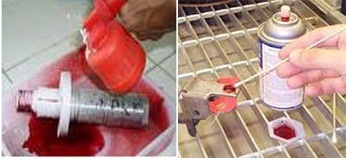
Lorem ipsum dolor sit amet, consectetur adipiscing elit. Ut elit tellus, luctus nec ullamcorper mattis, pulvinar dapibus leo.
Lorem ipsum dolor sit amet, consectetur adipiscing elit. Ut elit tellus, luctus nec ullamcorper mattis, pulvinar dapibus leo.
Lorem ipsum dolor sit amet, consectetur adipiscing elit. Ut elit tellus, luctus nec ullamcorper mattis, pulvinar dapibus leo.
Lorem ipsum dolor sit amet, consectetur adipiscing elit. Ut elit tellus, luctus nec ullamcorper mattis, pulvinar dapibus leo.
Lorem ipsum dolor sit amet, consectetur adipiscing elit. Ut elit tellus, luctus nec ullamcorper mattis, pulvinar dapibus leo.
Lorem ipsum dolor sit amet, consectetur adipiscing elit. Ut elit tellus, luctus nec ullamcorper mattis, pulvinar dapibus leo.
The penetrant may be applied to all non-ferrous materials and ferrous materials; although for ferrous components magnetic-particle inspection is often used instead for its subsurface detection capability. LPI is used to detect casting, forging and welding surface defects such as hairline cracks, surface porosity, leaks in new products, and fatigue cracks on in-service components.
The test surface is cleaned to remove any dirt, paint, oil, grease or any loose scale that could either keep penetrant out of a defect, or cause irrelevant or false indications. Cleaning methods may include solvents, alkaline cleaning steps, vapor degreasing, or metal blasting. The end goal of this step is a clean surface where any defects present are open to the surface, dirt, and free of contamination. Note that if metal blasting is used, it may “work over” small discontinuities in the part and an etching bath are recommended as a post-blasting treatment.
We can´t spell SUCCESS without You
Your trust and support drive our commitment to excellence. At SV TECH, we strive to deliver top-quality services tailored to your needs. Join hands with us and experience reliable, professional, and innovative solutions.
C-5076, Bhumi Commercial Complex, Kalamboli Street Market, Kalamboli, New Mumbai - 410218
Industrial Complex, MIDC Shiroli, Kolhapur-416122
K-181,Pocket-k,Sarita Vihar, New Delhi-110076.
A Satyanarayan. P.No. A/148,New Ramnagar, Chilka Nagar Hyderabad.
14 Bhaktinagar society,Near VImal Washing Factory, Vastral Road, Amraiwadi Ahmedabad.
About
WhatsApp us